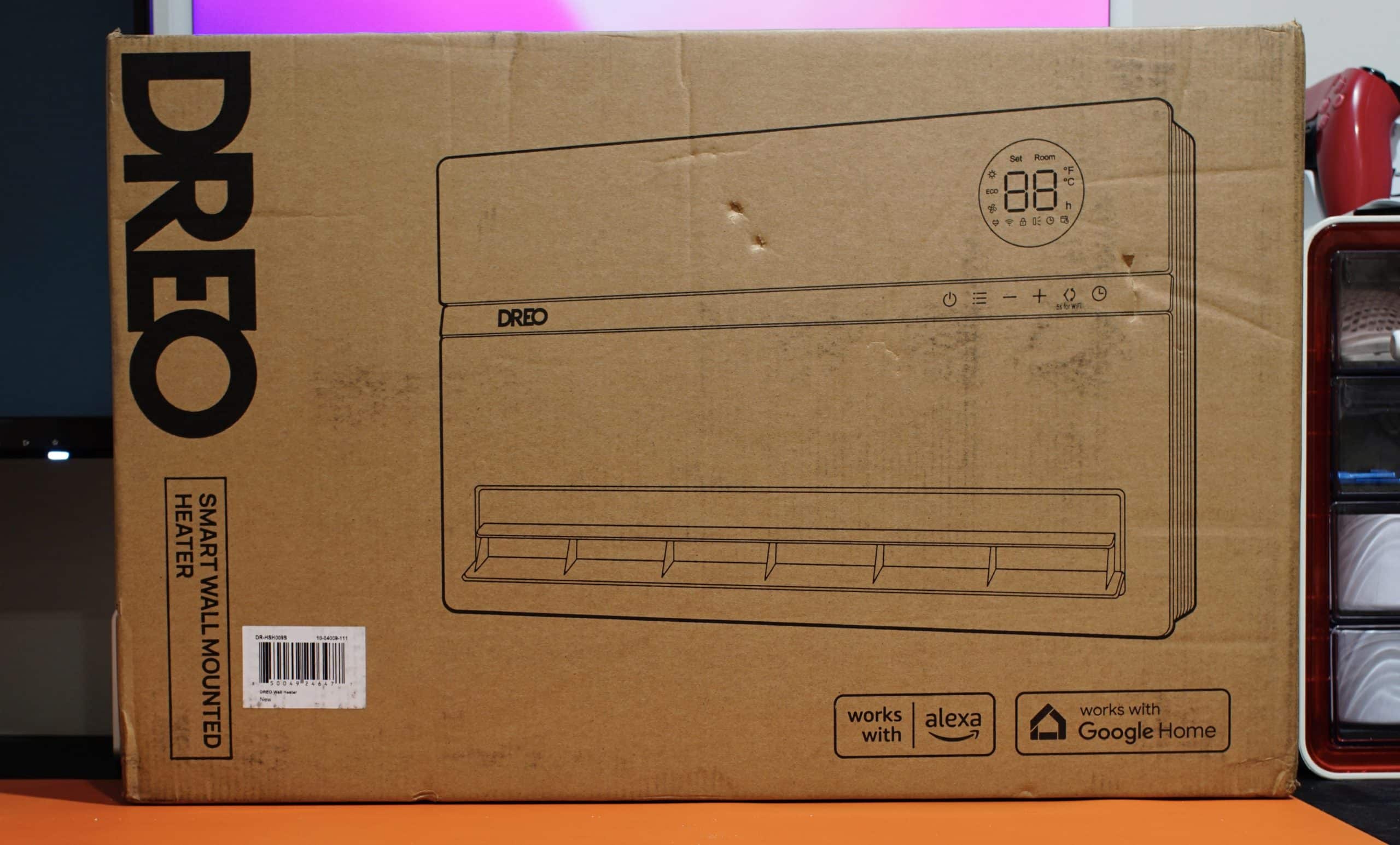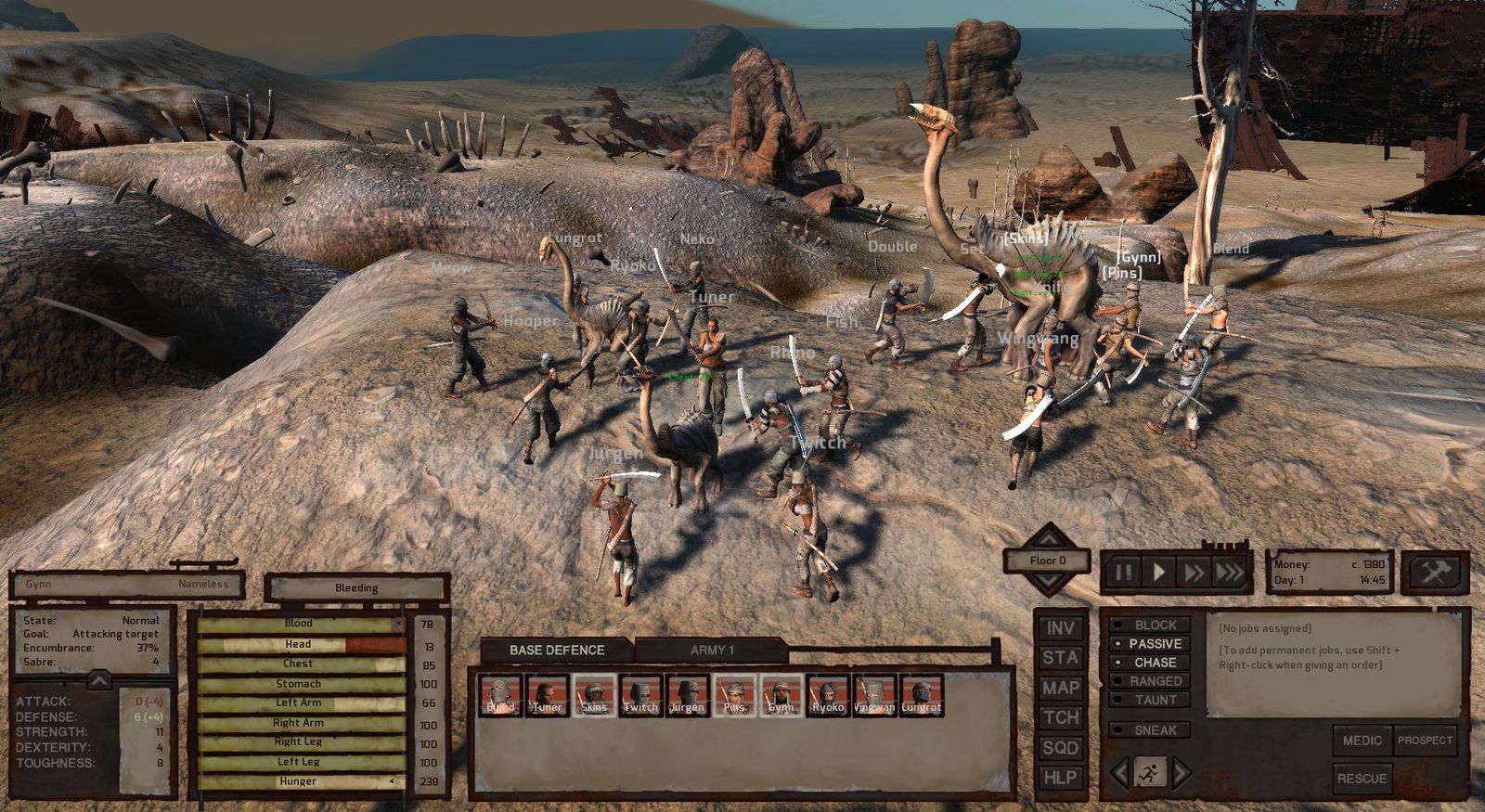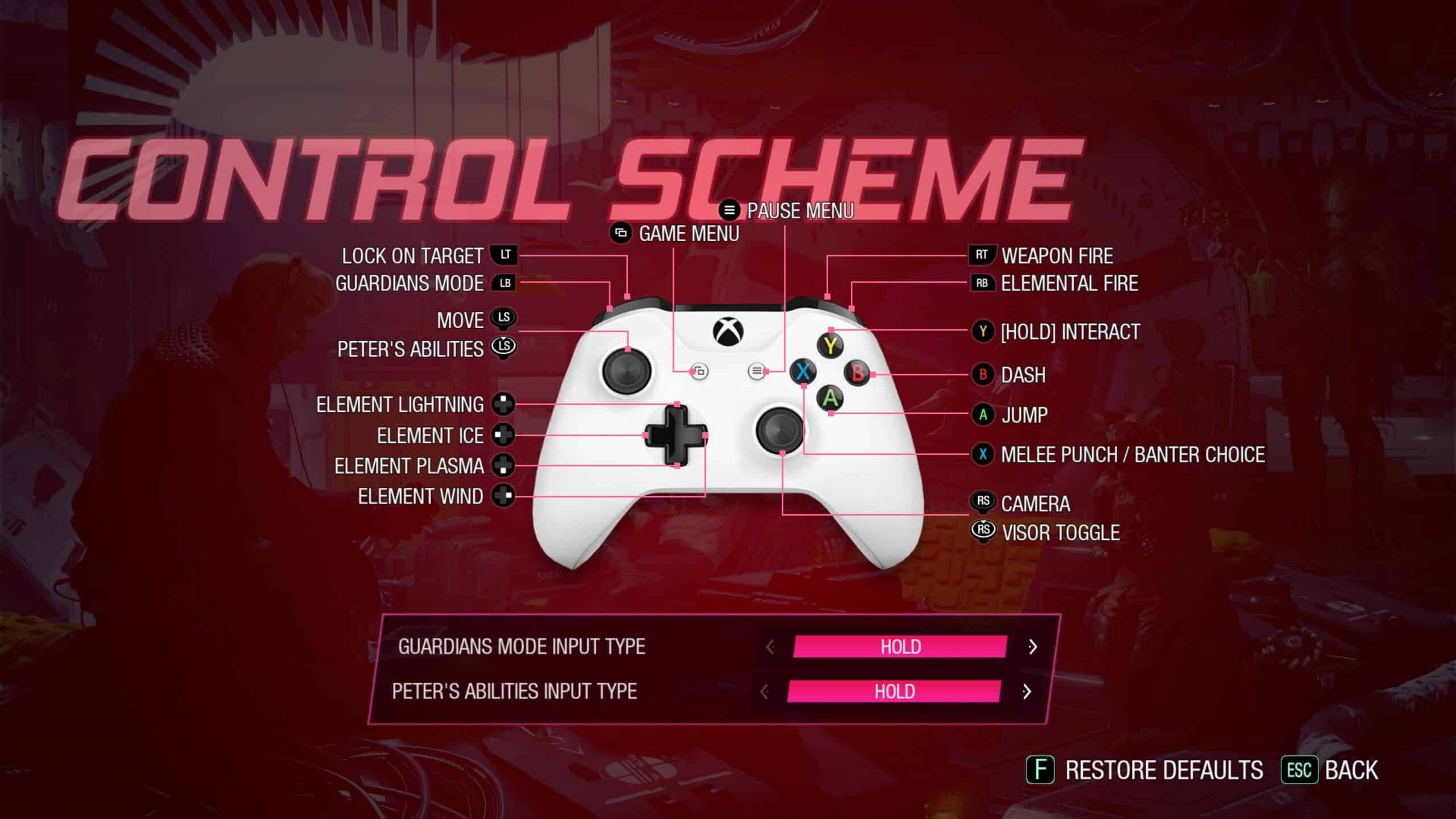Recently, Dreo has moved to revamp their product lines with smart features. These include options like PolyFan 513S, Macro Max S, and several others. As winter fast approaches, many players are starting to look into heating options. These range from more traditional devices like space heaters, or my Dyson Pure Hot+Cool, but among the most interesting is Dreo’s WH719S (Wall Heater). With a space saving design, clean look, and smart functionality; is it a scorching hot deal, or does it fail to effectively warm the room?
Dreo Wall Heater Review Overview
Unboxing
Instead of listing notable features, Dreo keeps it simple by merely confirming Alexa/Google Assistant support, color, and what WH719S actually is.
Inside is Styrofoam holding the WH719S in place, manual, screws to mount it, remote, and a mounting guide. This is one of the simplest unboxing experiences we’ve had, which speaks to how straightforward this wall heater actually is.
Do I need to Wall Mount?
Despite being a “wall mounted” heating unit, I can confirm WH719S works standing on its own. I strongly suggest reading the recommended guidelines before doing it, and keeping a couple things in mind.

First and foremost, the temperature sensor is on the bottom left of the device. Obstructing it can cause incorrect readings, and other related problems. The sensor can also not be moved to the other side. It also helps to be mindful of fin (bottom opening on the front) direction. Anything in its path will impact how effective this wall heater is.
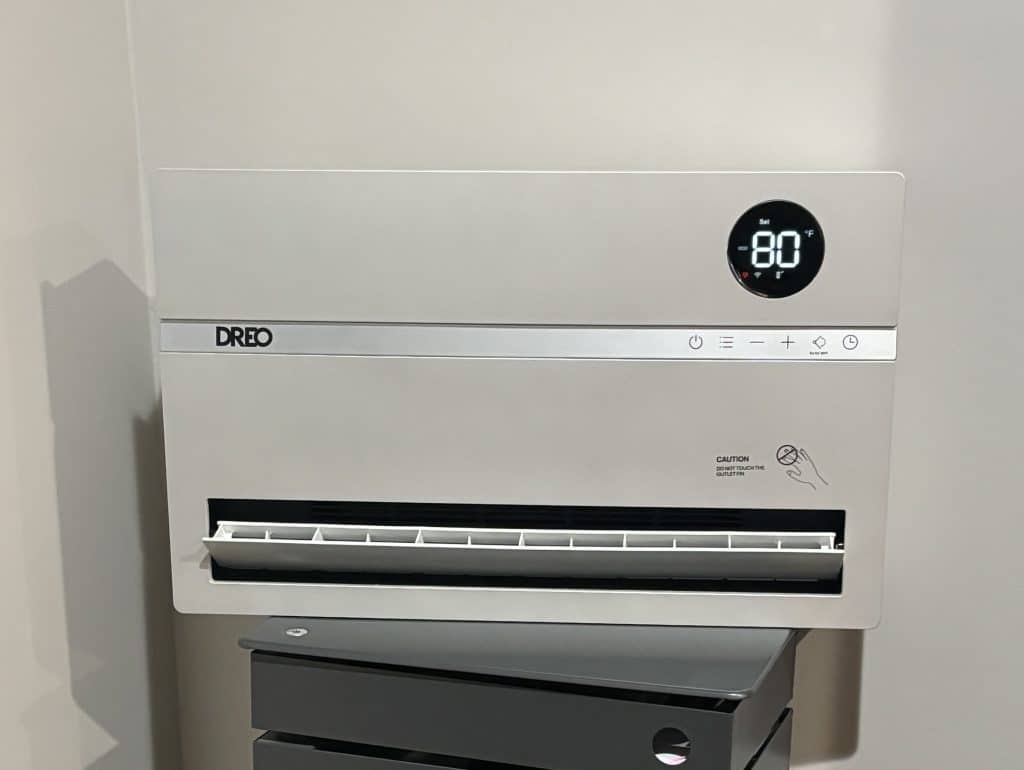
Still, I would suggest mounting it
That said, under normal usage I wouldn’t worry about the actual temperature. Even after an hour of continuous usage and the fins oscillating, the metal table it was standing on did not reach unsafe levels of heat. It also does not vent downward, so there are no concerns with this being blocked. Still, I wouldn’t suggest using it this way for an extended period of time and instead mount it, something Dreo makes incredibly easy.
Mounting
Let me start by saying, I love the included mounting guide. In addition to having a step-by-step picture guide, complete with guide holes, Dreo included a built-in level. This is an interesting addition that I honestly hope to see more of in the future. Finally, for those looking for even more assistance, there is a QR code for an instructional video.
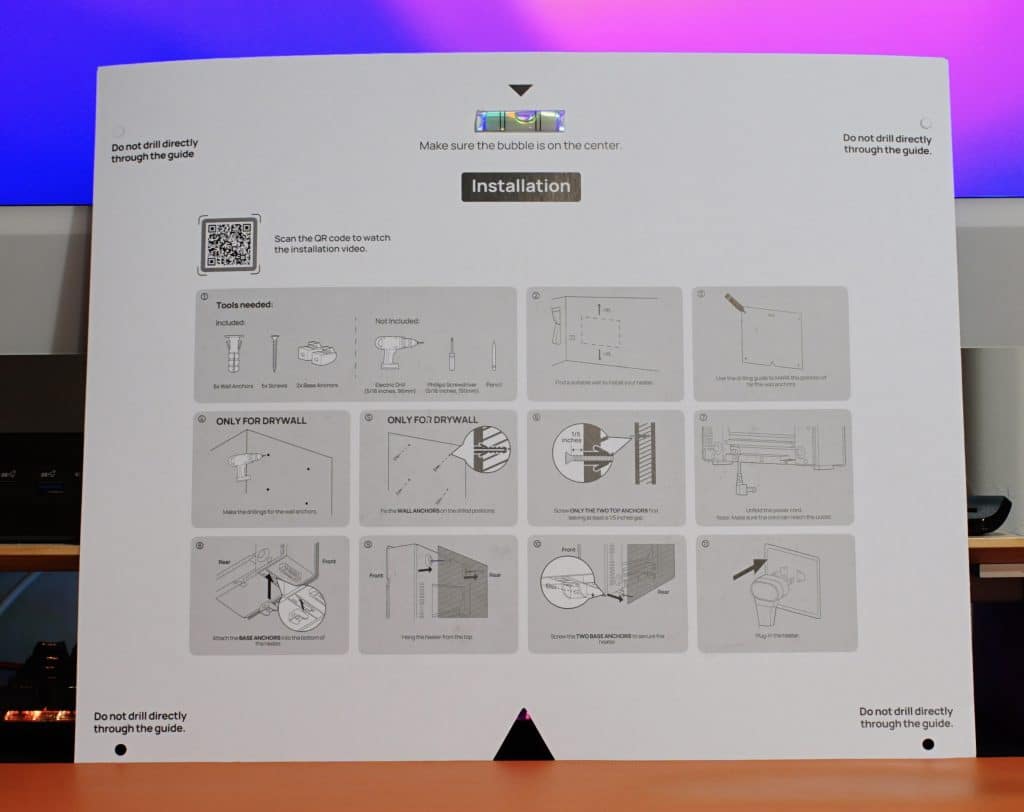
Simple and Effective
As long as you have access to a drill, and safe location to install, this should not be a hard install. Even as someone I would not describe as handy I had this installed in a couple minutes. It really is that easy to get the right tools, and safely mount this device.
Design
Contrary to images, WH719S is surprisingly light and compact. At 9~ lbs and 20.15″ x 12.75″ (13.75″ with wall bracket) x 4.5″ it should easily fit in most spaces. The white design with silver accent looks surprisingly well on my wall. There is also a hidden panel on the back to hide excess power cable length. It’s good in some situations, though better for storage/travel than hanging.
Compact Design
In terms of build quality, WH719S is basically a plastic box. I don’t think it would survive falling from off a wall, or having something hard thrown at it. Outside of that I wouldn’t anticipate any problems.
Wall Plug
Dreo’s Wall Heater line features three different models. These include the one this review is based off of, WH719S, along with WH729S, and WH739S. The only difference between these models is the type of wall plug they use.
Welcome to the World of Wall Plugs
With WH729S Dreo included their “Fort Plug” for an additional $10 ($140). This provides built-in thermal protection, ultimately turning the device off if it starts to overheat. As for WH739S, it comes with an ALCI Safety Plug. These are typically found on electronics used in a bathroom, such as a blow dryer. If that suits your specific needs, it will cost another $20 ($150).
Unfortunately, since I don’t have WH729S, or WH739S I can’t comment on how their plugs work. Based off images, WH719S should be the smallest plug coming in at about an inch. If space is not a concern, it comes down to whether you think the additional functionality is necessary.
Heating Performance
WH719S starts by working surprisingly fast. It takes about 10 seconds for warm air to appear, and another 20 seconds for it to become hot. Since this is all about how effectively it can heat a room, I waited for the same ambient temperature, closed my office door, set it to max power, and tracked how it performed over the course of an hour.
The chart below is the average of these three runs, rounded to the nearest 10 seconds. I also included the conversation to °Celsius to make things simpler.
| Time | °Fahrenheit | °Celsius |
| 0:00 | 69 | 20.56 |
| 4:10 | 70 | 21.11 |
| 4:50 | 71 | 21.67 |
| 6:40 | 72 | 22.22 |
| 7:10 | 73 | 22.78 |
| 9:50 | 74 | 23.33 |
| 10:40 | 75 | 23.89 |
| 12:10 | 76 | 24.44 |
| 13:10 | 77 | 25 |
| 44:50 | 78 | 25.56 |
| 58:00 | 79 | 26.11 |
You might notice there is a massive 30 minute gap between 77°f and 78°f. During this time WH719S would constantly cycle between 76°f and 77°f. Once it finally achieved 78°f it didn’t struggle to maintain it.
Since WH719S plateaus around 8°f above the unassisted ambient temperature, I found it was best to enable eco mode. Instead of a constant stream of warm air, eco mode tries to effectively maintain a specific temperature.
Usually this starts with a warm blast until it’s within a couple degrees, followed by a slow increase for the remainder. Once the desired temperature is achieved, WH719S will go into standby mode until needed. This saves money, along with simplifying the process of maintaining whatever temperature you desire.
Fan Performance
During warmer months WH719S doubles as a wall fan. It’s a nice feature, though it can be somewhat underwhelming. This is due to a lack of features, including control over fan speed. Unless you’re looking for ambient noise, or want to make the room slightly cooler, you’re still better off with something like PolyFan 513S.
Noise
How much noise WH719S depends on fan speed and oscillation. At the lowest fan speed noise is barely perceptible. Increasing to medium speed results a nice ambient noise. There is just enough to hear it, but not enough to be distracted by it. At max speed, which is also the only fan mode option, is quite noticeable.
Enabling oscillation will add a light hum as the motor moves the fins back and forth. Thankfully, it’s not very noticeable. Unless WH719S is shutting off, or set to the lowest speed, it gets lost in the fan noise.
When certain conditions are met it will also make a loud clicking noise. This typically happens when eco mode hits the desired temperature, though it can happen in other instances as well. It can be annoying to hear even if it’s not particularly common.
Application
Since this is a smart device, it can be added to Dreo’s expansive application in seconds. This remained an effortless pairing experience that took roughly 90 seconds to complete.
After connecting you can freely set the desired temperature between 41°f and 95°f in seconds. The same is true for mode, speed, fan angle, and more. Some notable options are tempreture unit, open window detection, calibration, and setting it to always show ambient temperature over current function.
Great Application to Use
Those looking for a truly customized experience can add schedules as well. These can be somewhat intimidating to add, though invaluable for anyone looking to come home, or wake up to a toasty room.
If nothing else, the application is great for turning it on when you need it most.
Google Home
If you don’t want to use your phone, WH719S also works with Google Home, or Alexa devices. Like Dreo’s other products this also works with a Google Home/Nest Hub.
It’s essentially a second (third?) remote for WH719S. Every option, besides sleep timer, is present here. It would be nice if it communicated more, like being able to see what the current temperature is. Still, it’s a nice alternative to a phone/remote that a lot of other devices don’t use in any way.
Remote
Dreo also included a traditional remote. It features a white body, seven rubber buttons, and spring loaded battery (CR2025) compartment. For the most part the remote is fine, though it could be a lot better.
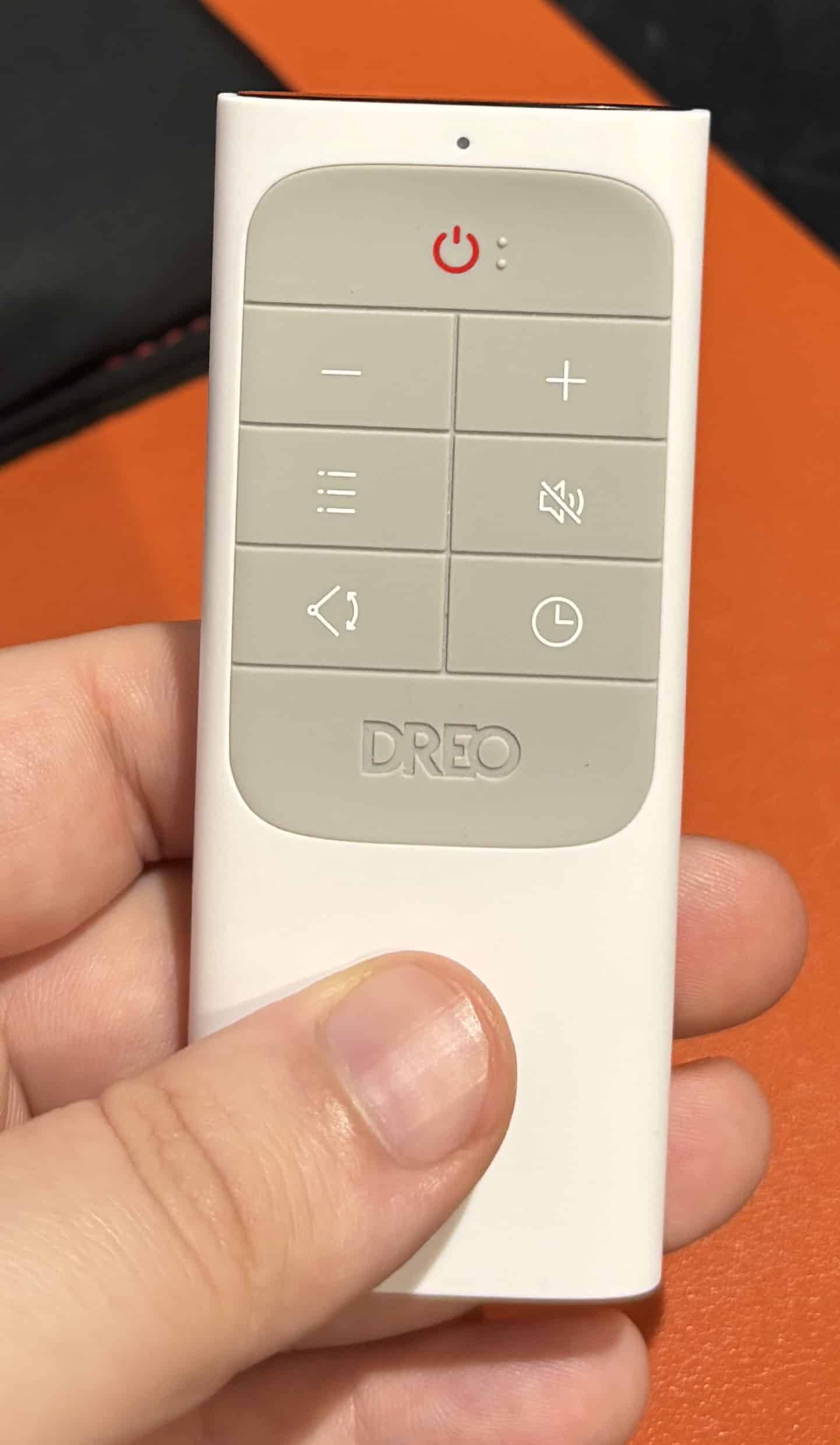
The included buttons are temperature down, up, mode, mute (it disables/enables a beep when a setting is changed), fan angle, and sleep timer. I’d personally remove mute, separate mode, and give them a more distinct icon than a couple dots with a line. Thankfully, this is the same icon on the device itself, I just think this small change would make these options easier to understand.
Cleaning
On the top of WH719S there are two screws and a spring loaded compartment holding the filter. This is pretty easy to access, and even easier to clean from time to time.
My one suggestion is to be mindful of this when mounting, as position can make this much harder to access than it needs to be.
Dreo Wall Heater Review Verdict

After a couple years of underwhelming performance from my Dyson, I was looking for a smart heater to replace it. Not only does WH719S exceed expectations, it does so in a way that looks better than the Dyson ever did. It would be nice if some minor changes were made, such as different remote icons/buttons, but overall it would be hard to improve on this product without vastly increasing cost. And, even then, it’s entirely possible Dreo updates their application to add new features/perks, such as lower speeds when using the fan. So, for these reasons and more I would say to pull the trigger if you’re in the market for a heater.
Editor’s Note: Dreo Wall Heater (WH719S) was provided to us for review purposes.

